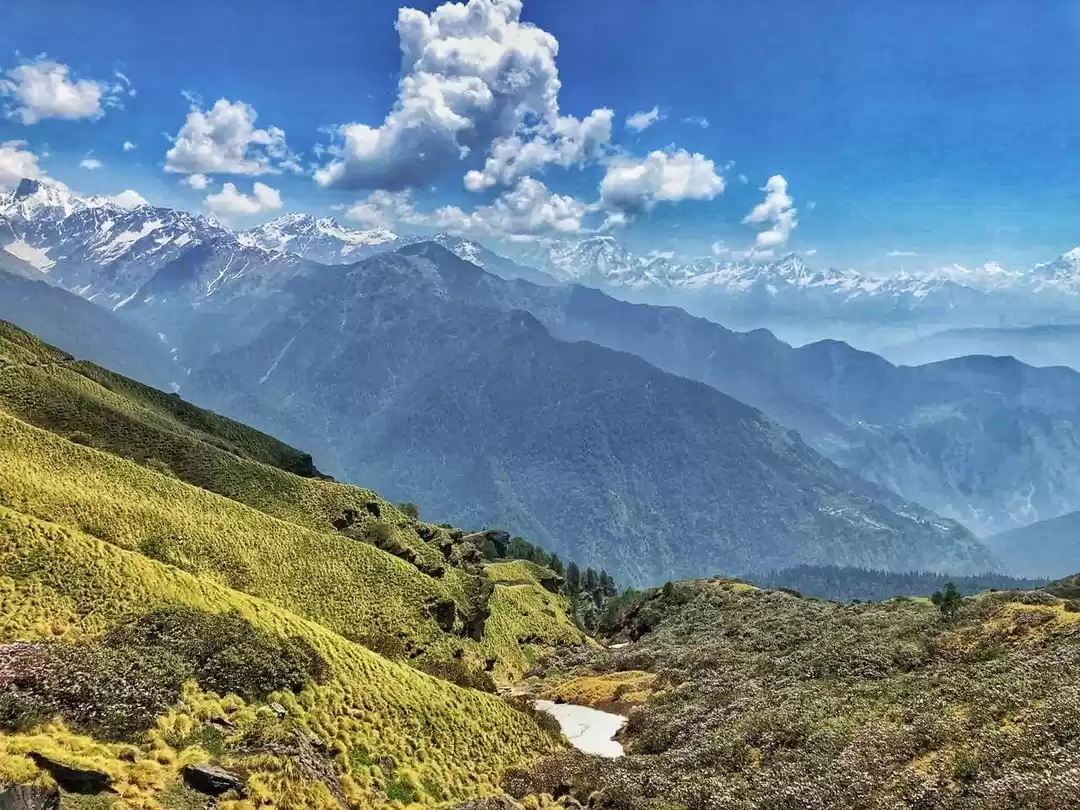If you’re looking for a Himalayan pilgrimage that feels less like a tourist trail and more like a journey into the soul of the mountains, Rudranath Temple is it.
Nestled deep in the Garhwal Himalayas of Uttarakhand, this ancient temple — one of the five sacred Panch Kedar shrines — isn’t about grandeur or convenience. It’s about silence. Solitude. And the kind of beauty that doesn’t shout, but settles into your bones.
And with renewed interest in offbeat spiritual treks and sustainable travel, Rudranath is quietly becoming the destination for those who want more than just a photo — they want an experience.
But let’s get one thing straight from the start:
Rudranath begins in Sagar Village, Mandal, or Urgam — quiet, remote hamlets in the lush valleys of Chamoli district. From there, the trail winds through dense forests, high-altitude meadows, and ancient woodlands, leading to a stone temple where Lord Shiva is believed to have revealed his face (mukha) after transforming into a buffalo (Mahisha) to escape the Pandavas.
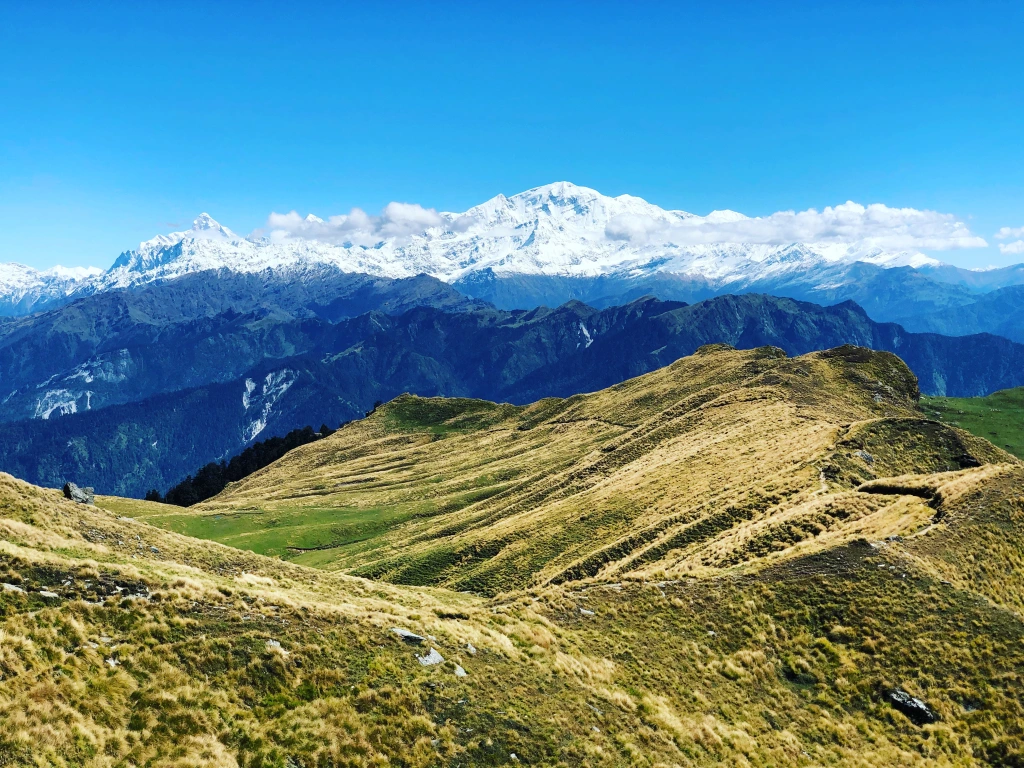
Yes — buffalo, not bull.
This is an important distinction in the legend, and one often glossed over. Shiva didn’t take the form of a gentle bull. He became a wild, powerful buffalo — a creature of strength and instinct — before disappearing into the earth. His body parts then reappeared at five different places, forming the Panch Kedar.
Rudranath is where his face emerged.
And that changes everything.
Because a face isn’t just anatomy. It’s identity. Recognition. When Shiva revealed his face here, it wasn’t just an appearance — it was an acknowledgment. A moment of stillness after flight.
And that’s exactly what you feel when you finally reach the temple: not triumph, but peace.
Why Rudranath in ? The Rise of the Quiet Pilgrimage
In recent years, travelers have begun turning away from crowded, commercialized routes. Places like Kedarnath and Badrinath, while deeply sacred, are now packed with pilgrims, helicopters, and roadside vendors.
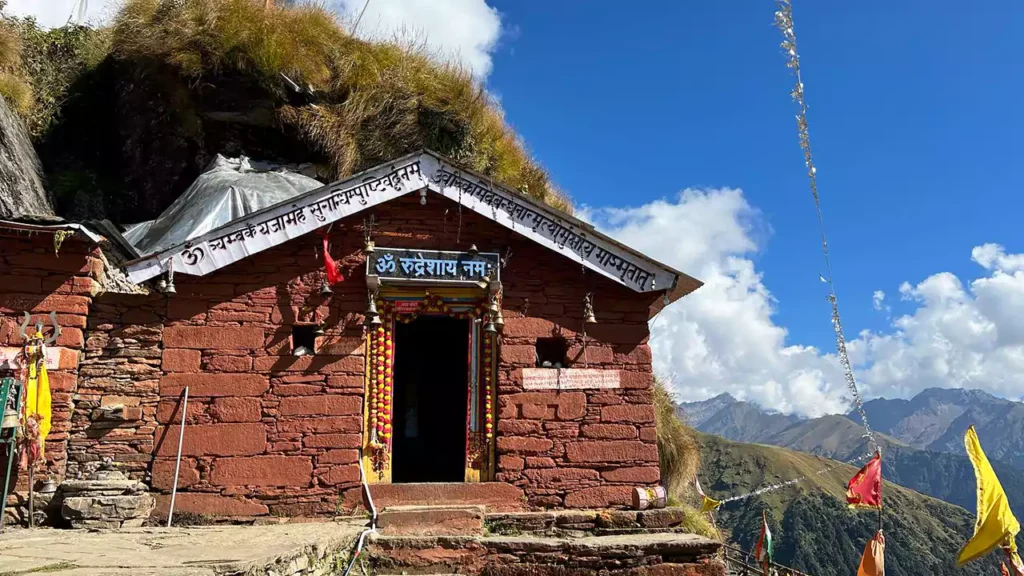
Rudranath? It’s the opposite.
There are no helicopter drops. No big hotels. No neon signs. No social media influencers posing dramatically in front of the sanctum.
Just you, the mountain, and a 1,000-year-old stone temple that feels like it belongs to the earth itself.
In 2025, with growing awareness around eco-tourism, mental wellness, and authentic travel, Rudranath is emerging as a destination for those who want to disconnect — not just from Wi-Fi, but from noise, rush, and distraction.
It’s not easy.
It’s not quick.
But it’s real.
And sometimes, that’s exactly what love, healing, or self-discovery needs.
The Real Starting Points: Sagar, Mandal & Urgam
Let’s clear up the confusion once and for all.
The Rudranath trek start from Sagar Village.
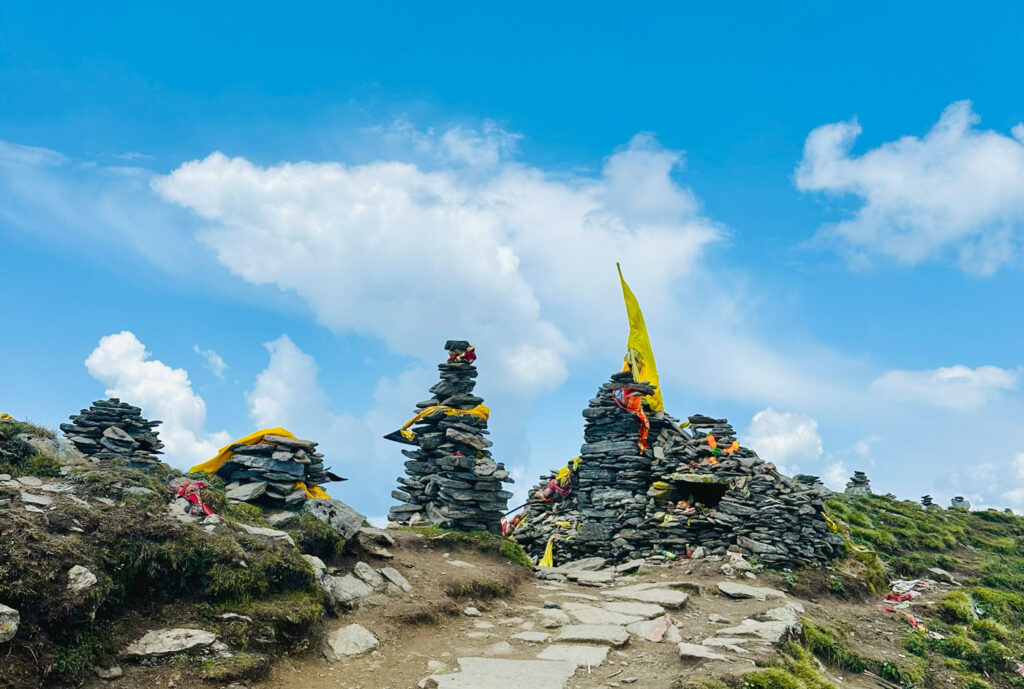
The actual starting points for Rudranath are:
1. Sagar Village
- Most common and well-marked route
- Last motorable point accessible by shared jeeps from Gopeshwar
- Trailhead begins here; 22 km to Rudranath
- Basic lodges and tea stalls available
2. Mandal
- Alternate starting point, slightly shorter than Sagar
- Connected by road to Gopeshwar (40 km)
- Scenic route through pine forests
- Less crowded than Sagar
3. Urgam
- Newer, less-traveled path
- Offers a more direct but steeper climb
- Popular among experienced trekkers
- Stunning views of the Nanda Devi range
No matter which route you take, one thing remains the same:
You walk. There’s no shortcut.
And that’s part of the magic.
The Trek Experience: 22 Kilometers of Wild Beauty
The Rudranath trek isn’t technically difficult — no ropes, no ice, no exposed ridges. But it’s long. And at 3,600 meters (11,800 ft), the altitude demands respect.
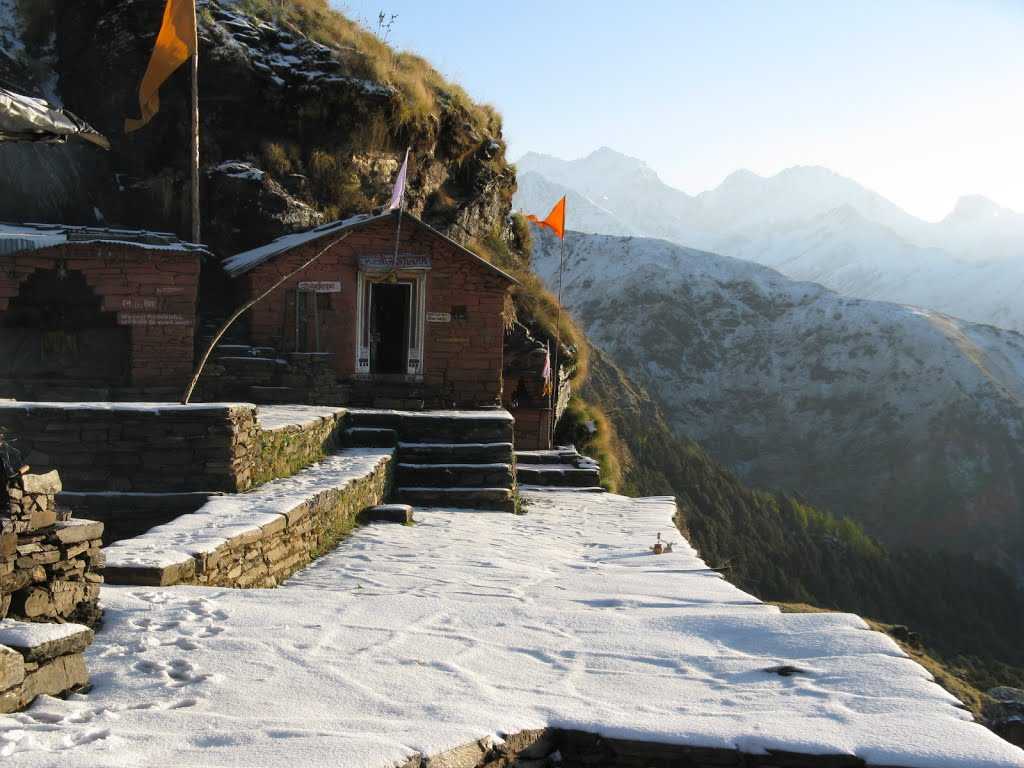
Here’s how the journey unfolds:
Day 1: Gopeshwar to Sagar (or Mandal/Urgam)
- Drive from Rishikesh or Haridwar to Gopeshwar (8–10 hours)
- Overnight in guesthouse or homestay
- Acclimatize, meet local guides, pack essentials
Day 2: Start the Trek
- Begin early (5–6 AM) to avoid afternoon clouds
- First 6–8 km through pine, deodar, and rhododendron forests
- Cross small streams — some with wooden bridges, others just stepping stones
- Occasional views of Trishul, Nanda Devi, and Chaukhamba peaks
- Stop at Mandal and urgam for Rest.
Day 3: Final Push to Rudranath
- Last 8 km — steeper, rockier, thinner air
- Enter high-altitude meadows (bugyals) dotted with wildflowers
- Temperature drops sharply; wind picks up
- Temple appears suddenly — half-hidden by trees and mist
The entire trek takes 2–3 days, depending on pace and fitness.
And yes — it’s exhausting.
Your legs ache.
Your lungs burn.
But the scenery? Unforgettable.
In spring (April–May), rhododendrons bloom in fiery reds and pinks. In summer (June–August), the meadows are green and buzzing with life. In autumn (September–October), the air is crisp, the skies clear, and the light golden.
Every season has its own mood.
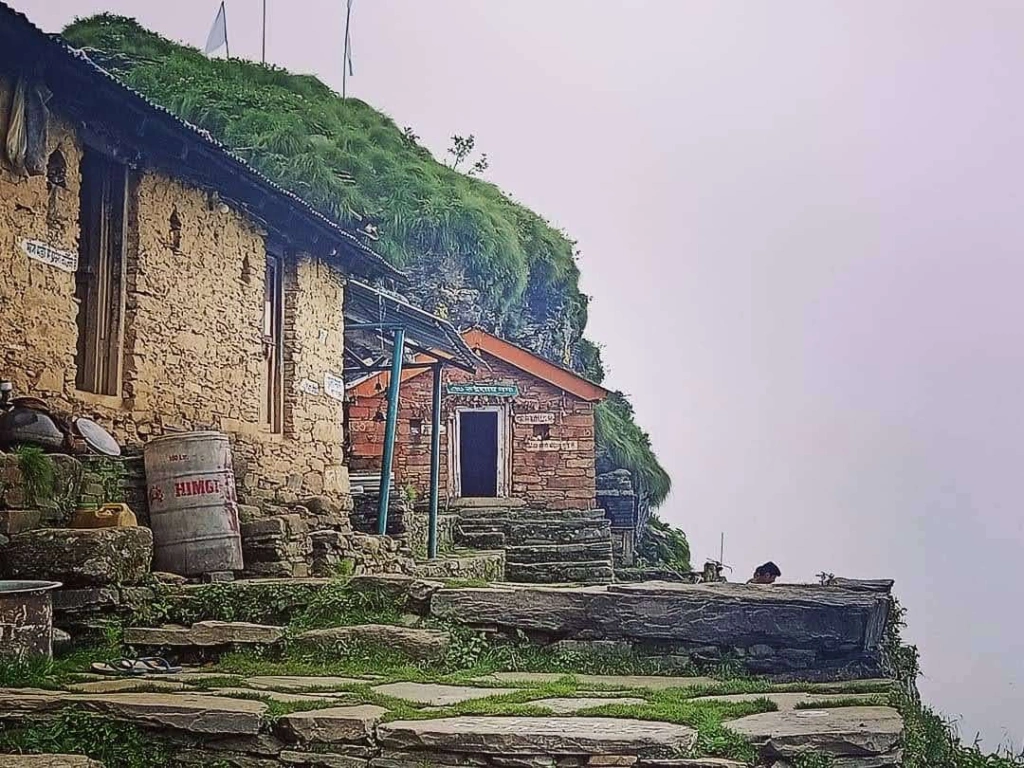
The Temple: Ancient, Simple, and Deeply Sacred
When you finally arrive, don’t expect marble floors or gold domes.
Rudranath Temple is simple stone architecture — grey slabs, sloped wooden roof, low ceilings. It blends into the mountain like it grew from the rock.
Inside, there’s no idol.
Just a natural rock formation believed to be Shiva’s face. It’s not carved. Not polished. Just there — emerging from the wall like a whisper.
Beside it, a natural lingam, covered in sandalwood paste, milk, and marigolds.
The air is thick with the smell of ghee, incense, and damp stone. A single oil lamp flickers. A priest chants softly — not for show, but because it’s time.
There’s no rush. No crowd. No loud bells.
Just stillness.
I sat on a stone ledge for nearly an hour. No prayers. No rituals. Just watching the light shift as clouds passed over the peaks.
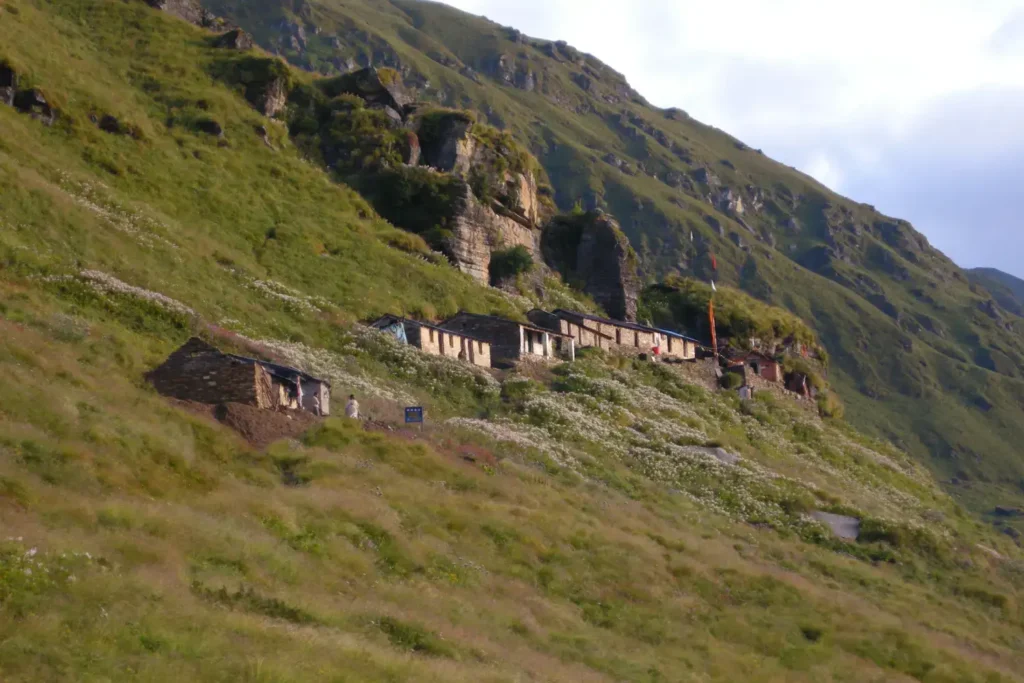
And then — get this — a Himalayan serow stepped out of the forest.
Looked at me.
Circled the temple once.
Vanished into the trees.
I didn’t blink.
I didn’t move.
Because in that moment, it didn’t feel like I was visiting a temple.
It felt like I was inside something alive.
The Legend: Shiva as the Buffalo, Not the Bull
Let’s revisit the story — accurately.
After the Mahabharata war, the Pandavas were haunted by guilt. They had won, but at a terrible cost. Seeking forgiveness, they searched for Lord Shiva.
But Shiva, weary of war and bloodshed, refused to appear.
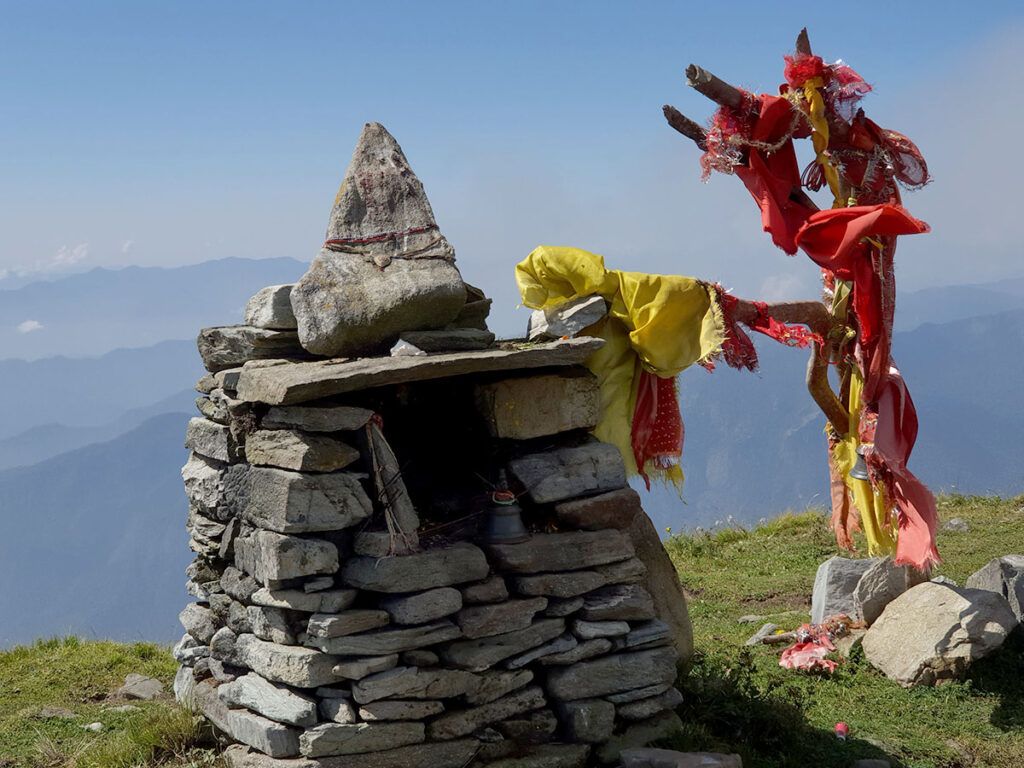
So he transformed into a buffalo (Mahisha) — not a bull — and vanished into the earth in the Garhwal Himalayas.
But he couldn’t hide completely.
His body parts reappeared at five places:
- Kedarnath – The hump
- Tungnath – The arms
- Rudranath – The face
- Madhyamaheshwar – The navel
- Kalpeshwar – The matted hair
The Pandavas built temples at each site.
Now, the buffalo form is significant.
A bull is domesticated. A buffalo is wild. Untamed. Powerful.
By choosing the buffalo, Shiva wasn’t just hiding — he was retreating into the raw, primal energy of nature.
And when his face appeared at Rudranath, it wasn’t submission.
It was recognition.
He saw the Pandavas.
And in that gaze, forgiveness began.
That’s why Rudranath feels different.
It’s not about power.
It’s about presence.
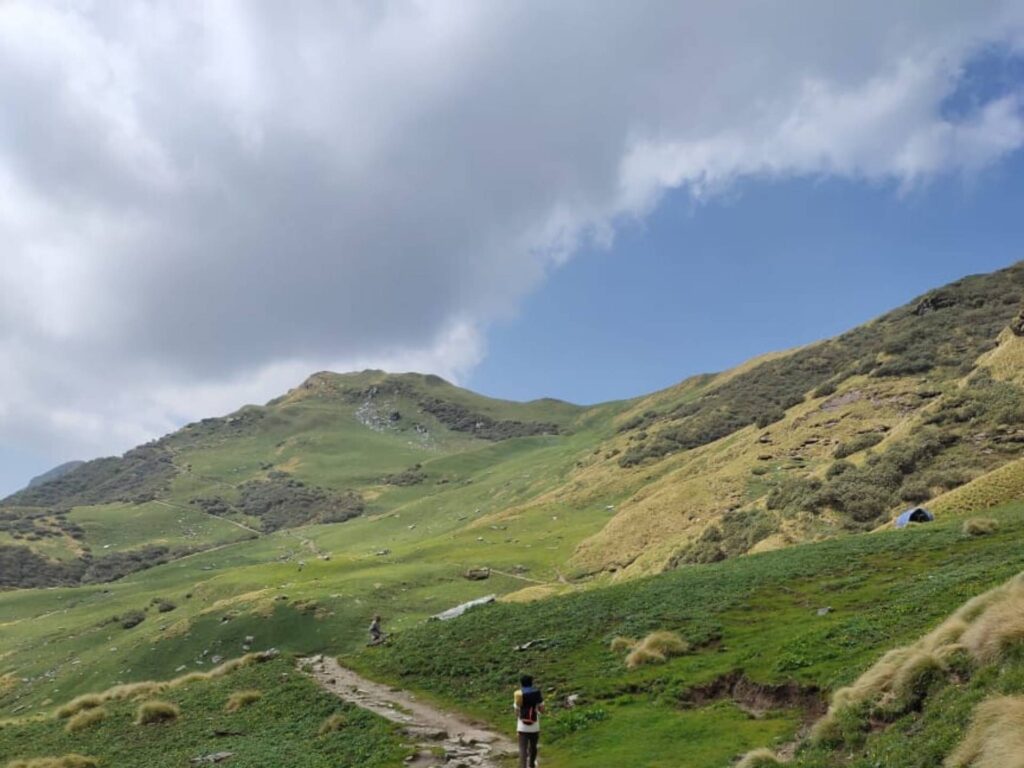
Scenic Highlights Along the Trail
The Rudranath trek is one of the most underrated in the Himalayas. Here’s what you’ll see:
- Rhododendron forests – In spring, they bloom like fire
- High-altitude meadows – Perfect for camping under the stars
- Wildlife – Serow, langurs, Himalayan monal (rare pheasant)
- Ancient deodar trees – Some over 300 years old
- Crystal-clear streams – Drinkable (if boiled)
- Panoramic views – Nanda Devi, Trishul, Chaukhamba
- Local shepherds – Grazing their flocks, living off the land
It’s not just a trek.
It’s a journey through untouched Himalayan life.
Rudranath Travel Packages (2025)
If you’re not up for planning everything yourself, several trusted operators offer Rudranath trek packages. Here are the most reliable:
1. Basic Pilgrim Package (₹8,000–12,000 per person)
- Includes: Gopeshwar to Sagar transport, guide, basic lodging, meals
- Duration: 4 days
- Best for: Solo pilgrims, budget travelers
2. Couple’s Spiritual Retreat (₹18,000–25,000)
- Private guide, homestays, Ayurvedic meals, meditation sessions
- Romantic add-ons: Bonfire, stargazing, journaling kits
- Duration: 5 days
3. Adventure Trekker’s Package (₹15,000–20,000)
- Full trek gear, experienced guide, first-aid kit
- Options to extend to Tungnath or Chandrashila
- Eco-friendly practices emphasized
Note: Always choose operators who follow Leave No Trace principles and support local communities.
Safety Tips for the 2025 Rudranath Trek
This isn’t a walk in the park. Respect the mountain.
1. Acclimatize First
- Spend a night in Gopeshwar or Sagar before starting
- Altitude sickness is real — watch for dizziness, nausea, headache
2. Start Early
- Begin by 5–6 AM to avoid afternoon clouds and storms
- Afternoon rains are common in monsoon
3. Pack Smart
- Warm layers (thermal, fleece, jacket)
- Waterproof trekking shoes
- Gloves, cap, scarf
- 2L water, snacks, power bank
- First-aid kit, ID, emergency contact
4. Respect the Trail
- No plastic — carry all waste back
- No loud music or shouting
- Remove shoes before final stretch
5. Check Weather
- Monsoon (July–August) brings landslides
- Best time: Late May to October
6. Travel with a Guide
- Local guides know the terrain and weather patterns
- Supports the community
Why Rudranath Should Be on Your 2025 List
Because it’s not about convenience.
It’s about intention.
In a world where everything is fast, loud, and clickable, Rudranath is slow, quiet, and hidden.
It doesn’t need your attention.
It doesn’t want your likes.
It just is.
And if you’re willing to walk far enough, climb high enough, and listen closely enough — it might just speak to you.
Not in words.
But in silence.
FAQs
Q1. Where is Rudranath Temple located?
Rudranath Temple is situated in the Chamoli district of Uttarakhand, amidst the Garhwal Himalayas.
Q2. Why is Rudranath Temple famous?
It is one of the Panch Kedar temples where Lord Shiva’s face is worshipped. The temple is also popular for its high-altitude trek and divine atmosphere.
Q3. How can I reach Rudranath Temple?
The temple is accessible only by trekking routes from Sagar, Lyuti Bugyal, or Panar Bugyal. The trek ranges between 20–24 km depending on the starting point.
Q4. What is the best time to visit Rudranath Temple?
May to October is ideal, as the temple remains closed during winter due to heavy snowfall.
Q5. Is Rudranath Temple connected to Mahabharata legends?
Yes, it is believed that the Pandavas built the Panch Kedar temples while seeking forgiveness from Lord Shiva.

